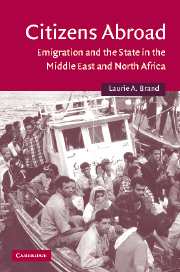Book contents
- Frontmatter
- Contents
- List of tables
- Preface
- List of acronyms
- 1 States and their citizens abroad
- 2 State sovereignty, state resilience
- 3 Morocco: expatriates as subjects or citizens?
- 4 Tunisia's expatriates: an integral part of the national community?
- 5 Lebanon and its expatriates: a bird with two wings
- 6 Jordan: unwilling citizens, problematic expatriates
- Conclusions: transnationalism, security and sovereignty
- Bibliography
- Index
- Cambridge Middle East Studies 23
5 - Lebanon and its expatriates: a bird with two wings
Published online by Cambridge University Press: 22 September 2009
- Frontmatter
- Contents
- List of tables
- Preface
- List of acronyms
- 1 States and their citizens abroad
- 2 State sovereignty, state resilience
- 3 Morocco: expatriates as subjects or citizens?
- 4 Tunisia's expatriates: an integral part of the national community?
- 5 Lebanon and its expatriates: a bird with two wings
- 6 Jordan: unwilling citizens, problematic expatriates
- Conclusions: transnationalism, security and sovereignty
- Bibliography
- Index
- Cambridge Middle East Studies 23
Summary
Of the cases covered in this book, Lebanon's migration is the oldest and its communities the most widespread. Beginning with waves directed principally toward the Western Hemisphere in the late nineteenth and early twentieth centuries, significant diaspora communities subsequently developed in Africa and then in the oil states of the Persian Gulf. With the outbreak of civil war in 1975, new groups left; some changed the confessional composition of existing communities, while others began to shape the development of largely new groupings in Canada, Europe and Australia. The long and varied Lebanese emigrant experience has also given rise to more diverse terminology for those who have left than one finds in other cases. In Lebanese discussions of the topic, the most common term for those abroad is mughtarib (“expatriate”), although in recent years al-intishar (a word akin to diaspora) has gained increasing currency, just as one finds the terms mutahaddir (“descendant,” referring to the second, third and fourth generations) and muhajir (“one who has emigrated/fled”).
Like Morocco and Tunisia, Lebanon witnessed the beginnings of significant emigration during the pre-independence period. However, unlike the Maghrebi cases, Lebanese emigration was undertaken on individual initiative, not on a colonial government-organized work-contract basis. At the beginning of the migration, the territory was part of the Ottoman Empire, and what was finally delineated as the Lebanese state did not coincide with the historical boundaries of Mt. Lebanon.
- Type
- Chapter
- Information
- Citizens AbroadEmigration and the State in the Middle East and North Africa, pp. 133 - 175Publisher: Cambridge University PressPrint publication year: 2006



